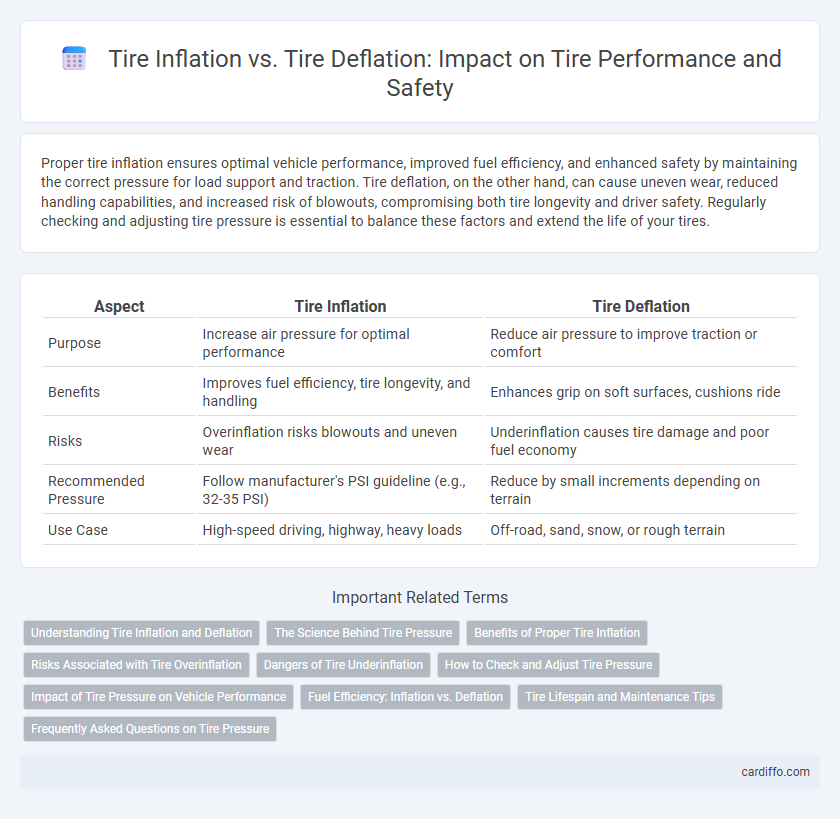Proper tire inflation ensures optimal vehicle performance, improved fuel efficiency, and enhanced safety by maintaining the correct pressure for load support and traction. Tire deflation, on the other hand, can cause uneven wear, reduced handling capabilities, and increased risk of blowouts, compromising both tire longevity and driver safety. Regularly checking and adjusting tire pressure is essential to balance these factors and extend the life of your tires.
Table of Comparison
| Aspect | Tire Inflation | Tire Deflation |
|---|---|---|
| Purpose | Increase air pressure for optimal performance | Reduce air pressure to improve traction or comfort |
| Benefits | Improves fuel efficiency, tire longevity, and handling | Enhances grip on soft surfaces, cushions ride |
| Risks | Overinflation risks blowouts and uneven wear | Underinflation causes tire damage and poor fuel economy |
| Recommended Pressure | Follow manufacturer's PSI guideline (e.g., 32-35 PSI) | Reduce by small increments depending on terrain |
| Use Case | High-speed driving, highway, heavy loads | Off-road, sand, snow, or rough terrain |
Understanding Tire Inflation and Deflation
Tire inflation involves maintaining the optimal air pressure to ensure maximum contact between the tire and the road, improving fuel efficiency, handling, and tire longevity. Tire deflation occurs when air pressure drops below the recommended level, leading to increased rolling resistance, uneven tire wear, and potential safety hazards such as blowouts. Monitoring tire pressure regularly with a reliable gauge helps prevent underinflation or overdeflation, enhancing vehicle performance and safety.
The Science Behind Tire Pressure
Tire inflation involves increasing the air pressure inside the tire to the recommended level, which enhances tire rigidity, improves fuel efficiency, and ensures optimal contact with the road surface. Tire deflation, conversely, decreases internal air pressure, leading to increased rolling resistance, uneven tire wear, and reduced vehicle stability. The science behind tire pressure relies on maintaining the ideal balance between load support and tire flexibility, governed by the principles of gas laws and structural mechanics to optimize performance and safety.
Benefits of Proper Tire Inflation
Proper tire inflation improves fuel efficiency by reducing rolling resistance, leading to lower fuel consumption and emissions. Maintaining correct tire pressure enhances vehicle safety through better handling, braking performance, and reduced risk of blowouts. Proper inflation also extends tire lifespan by ensuring even tread wear, saving money on premature replacements.
Risks Associated with Tire Overinflation
Tire overinflation reduces the contact area between the tire and road, leading to decreased traction and increased risk of uneven wear, particularly in the center tread. Excessive pressure raises the likelihood of tire blowouts due to heightened stress on the tire structure, compromising safety during high-speed driving or under heavy loads. Overinflated tires also result in a harsh ride quality and may negatively impact vehicle handling and braking performance, elevating overall driving risk.
Dangers of Tire Underinflation
Tire underinflation significantly increases the risk of tire blowouts by causing excessive heat buildup during driving, which compromises tire integrity and safety. Underinflated tires also lead to uneven tread wear, reducing traction and increasing the likelihood of hydroplaning in wet conditions. Maintaining proper tire pressure, as recommended by vehicle manufacturers, optimizes fuel efficiency and ensures maximum control, preventing dangerous driving scenarios caused by tire deflation.
How to Check and Adjust Tire Pressure
Checking tire pressure involves using a reliable tire pressure gauge to measure the current PSI against the manufacturer's recommended levels found in the vehicle's manual or on the door placard. To adjust tire pressure, add air with an air compressor if the pressure is too low or release air by pressing the valve stem if it is too high, ensuring the tire reaches the optimal PSI for safety and efficiency. Regularly monitoring tire inflation improves fuel economy, tire longevity, and overall vehicle performance.
Impact of Tire Pressure on Vehicle Performance
Optimal tire inflation significantly enhances vehicle performance by improving fuel efficiency, handling, and tire lifespan. Underinflated tires cause increased rolling resistance, leading to higher fuel consumption, reduced traction, and uneven tire wear. Overinflated tires reduce the contact patch, compromising ride comfort and increasing the risk of tire damage and blowouts.
Fuel Efficiency: Inflation vs. Deflation
Proper tire inflation significantly enhances fuel efficiency by reducing rolling resistance, allowing vehicles to consume less fuel during operation. Underinflated tires cause increased friction and energy loss, leading to higher fuel consumption and increased emissions. Maintaining optimal tire pressure ensures maximum fuel economy, longer tire lifespan, and improved vehicle safety.
Tire Lifespan and Maintenance Tips
Proper tire inflation significantly extends tire lifespan by ensuring even tread wear and optimal contact with the road, preventing premature damage and blowouts. Underinflated tires increase rolling resistance, leading to higher fuel consumption and accelerated tread wear, while overinflated tires reduce traction and cause uneven wear patterns, compromising safety. Regularly checking tire pressure, using a reliable gauge, and maintaining inflation at manufacturer-recommended levels are essential maintenance practices to maximize tire durability and performance.
Frequently Asked Questions on Tire Pressure
Proper tire inflation ensures optimal fuel efficiency, improved vehicle handling, and extended tire lifespan, while tire deflation can lead to increased wear, reduced safety, and poor mileage. Common questions about tire pressure include how often to check it, the recommended PSI for different vehicles, and the effects of temperature changes on pressure levels. Maintaining the correct tire pressure according to the manufacturer's specifications is crucial for both safety and performance.
Tire inflation vs Tire deflation Infographic

 cardiffo.com
cardiffo.com